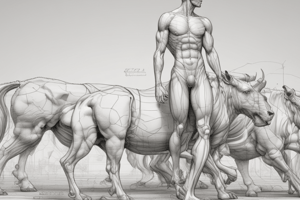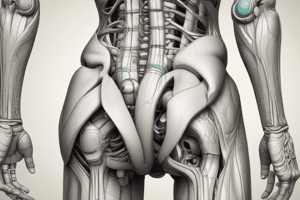Podcast
Questions and Answers
Which action is primarily associated with the gluteus medius muscle?
Which action is primarily associated with the gluteus medius muscle?
- Hip flexion
- Hip abduction (correct)
- Hip adduction
- Hip extension
The piriformis muscle is known to perform which action on the hip joint?
The piriformis muscle is known to perform which action on the hip joint?
- Adduction of flexed hip
- Flexion of extended hip
- External rotation of extended hip (correct)
- Internal rotation of extended hip
What is the primary action of the psoas major and minor muscles?
What is the primary action of the psoas major and minor muscles?
- Hip extension and trunk extension
- Hip abduction and trunk rotation
- Hip adduction and trunk stabilization
- Hip flexion and trunk flexion when the femur is fixed (correct)
Which of the following muscles inserts on the tibial tuberosity via the patellar tendon?
Which of the following muscles inserts on the tibial tuberosity via the patellar tendon?
What combination of actions is performed by the sartorius muscle?
What combination of actions is performed by the sartorius muscle?
The gracilis muscle shares its distal insertion point (pes anserinus) with which other muscle?
The gracilis muscle shares its distal insertion point (pes anserinus) with which other muscle?
Which of the following muscles primarily contributes to hip extension, knee flexion, and internal rotation of the knee?
Which of the following muscles primarily contributes to hip extension, knee flexion, and internal rotation of the knee?
The long head of biceps femoris is unique compared to its short head because it contributes to what additional action?
The long head of biceps femoris is unique compared to its short head because it contributes to what additional action?
Pelvic rotations, such as anterior and posterior tilts, are best described as:
Pelvic rotations, such as anterior and posterior tilts, are best described as:
What action is produced by the gastrocnemius muscle?
What action is produced by the gastrocnemius muscle?
Which of the following best describes the action of the soleus muscle?
Which of the following best describes the action of the soleus muscle?
What combination of actions does the tibialis anterior muscle perform on the foot?
What combination of actions does the tibialis anterior muscle perform on the foot?
During an ankle sprain caused by excessive inversion, which two ligaments are most commonly injured?
During an ankle sprain caused by excessive inversion, which two ligaments are most commonly injured?
Which of the following muscles causes trunk flexion and posterior pelvic tilt?
Which of the following muscles causes trunk flexion and posterior pelvic tilt?
Which muscle group performs trunk extension and lateral flexion?
Which muscle group performs trunk extension and lateral flexion?
What action is performed by both the external and internal obliques?
What action is performed by both the external and internal obliques?
How many vertebrae are located in the thoracic segment of the spinal column?
How many vertebrae are located in the thoracic segment of the spinal column?
What anatomical feature is the primary load-bearing part of a vertebra?
What anatomical feature is the primary load-bearing part of a vertebra?
What is the primary function of facet joints within the vertebral column?
What is the primary function of facet joints within the vertebral column?
Intervertebral discs primarily serve which of the following purposes?
Intervertebral discs primarily serve which of the following purposes?
Flashcards
Gluteus Maximus Origin
Gluteus Maximus Origin
Posterior iliac crest, sacrum, соссух.
Gluteus Maximus Insertion
Gluteus Maximus Insertion
Gluteal tuberosity of femur, IT band.
Gluteus Maximus Actions
Gluteus Maximus Actions
Hip extension, external rotation.
Gluteus Medius Origin
Gluteus Medius Origin
Signup and view all the flashcards
Gluteus Medius Insertion
Gluteus Medius Insertion
Signup and view all the flashcards
Gluteus Medius Actions
Gluteus Medius Actions
Signup and view all the flashcards
Piriformis Origin
Piriformis Origin
Signup and view all the flashcards
Piriformis Insertion
Piriformis Insertion
Signup and view all the flashcards
Piriformis Actions
Piriformis Actions
Signup and view all the flashcards
Rectus Femoris Origin
Rectus Femoris Origin
Signup and view all the flashcards
Rectus Femoris Insertion
Rectus Femoris Insertion
Signup and view all the flashcards
Rectus Femoris Actions
Rectus Femoris Actions
Signup and view all the flashcards
Vastus Medialis Origin
Vastus Medialis Origin
Signup and view all the flashcards
Vastus Medialis Insertion
Vastus Medialis Insertion
Signup and view all the flashcards
Vastus Medialis Actions
Vastus Medialis Actions
Signup and view all the flashcards
Tibialis Anterior Origin
Tibialis Anterior Origin
Signup and view all the flashcards
Tibialis Anterior Insertion
Tibialis Anterior Insertion
Signup and view all the flashcards
Tibialis Anterior Actions
Tibialis Anterior Actions
Signup and view all the flashcards
Lordosis
Lordosis
Signup and view all the flashcards
Kyphosis
Kyphosis
Signup and view all the flashcards
Study Notes
Hip and Pelvis Muscles
- Gluteus Maximus Origin: Posterior iliac crest, sacrum, coccyx
- Gluteus Maximus Insertion: Gluteal tuberosity of femur, IT band
- Gluteus Maximus actions include hip extension and external rotation
- Upper fibers of the gluteus maximus cause abduction
- Lower fibers of the gluteus maximus cause adduction
- Gluteus Medius Origin: Outer surface of the ilium
- Gluteus Medius Insertion: Lateral surface of greater trochanter
- Gluteus Medius action is hip abduction
- Anterior fibers of the gluteus medius cause internal rotation
- Posterior fibers of the gluteus medius cause external rotation
- Piriformis Origin: Anterior surface of sacrum
- Piriformis Insertion: Greater trochanter of femur
- Piriformis Actions: External rotation of extended hip, abduction of flexed hip
- Psoas Major and Minor Origin: T12-L5 vertebral bodies and transverse processes (Major); T12 & L1 vertebrae (Minor)
- Psoas Major and Minor Insertion: Lesser trochanter of femur (Major); pectineal line (Minor)
- Psoas Major and Minor Actions: Hip flexion, trunk flexion when femur is fixed
Knee and Thigh Muscles
- Rectus Femoris Origin: Anterior inferior iliac spine (AIIS)
- Rectus Femoris Insertion: Tibial tuberosity via patellar tendon
- Rectus Femoris Actions: Knee extension, hip flexion
- Vastus Medialis Origin: Linea aspera (medial lip)
- Vastus Medialis Insertion: Tibial tuberosity via patellar tendon
- Vastus Medialis Action: Knee extension
- Vastus Intermedius Origin: Anterior and lateral surface of femur
- Vastus Intermedius Insertion: Tibial tuberosity via patellar tendon
- Vastus Intermedius Action: Knee extension
- Sartorius Origin: Anterior superior iliac spine (ASIS)
- Sartorius Insertion: Medial tibia (pes anserinus)
- Sartorius Actions: Hip flexion, abduction, external rotation; knee flexion
- Gracilis Origin: Inferior pubic ramus
- Gracilis Insertion: Medial surface of tibia (pes anserinus)
- Gracilis Actions: Hip adduction, knee flexion, internal rotation of knee
- Semimembranosus Origin: Ischial tuberosity
- Semimembranosus Insertion: Posterior medial tibial condyle
- Semimembranosus Actions: Hip extension, knee flexion, internal rotation of knee
- Biceps Femoris Origin (Long head): Ischial tuberosity
- Biceps Femoris Origin (Short head): Linea aspera
- Biceps Femoris Insertion: Head of fibula
- Biceps Femoris Actions: Knee flexion, external rotation; hip extension (long head)
Hip and Pelvis Movements
- Common hip joint movements include flexion, extension, abduction, adduction, internal rotation, and external rotation
- Pelvic tilt/rotation includes anterior tilt (hip flexion), posterior tilt (hip extension), lateral tilt (hip abduction/adduction), and rotation (internal/external rotation)
- Pelvic rotations are movements of the pelvis, not the hip joint itself, but do influence hip movement and alignment
Ankle and Foot Muscles
- Gastrocnemius Origin: Posterior surfaces of medial and lateral femoral condyles
- Gastrocnemius Insertion: Posterior surface of calcaneus via Achilles tendon
- Gastrocnemius Actions: Plantar flexion of the ankle, assists with knee flexion
- Soleus Origin: Posterior surface of proximal tibia and fibula
- Soleus Insertion: Posterior calcaneus via Achilles tendon
- Soleus Action: Plantar flexion of the ankle
- Tibialis Anterior Origin: Lateral condyle and upper lateral surface of tibia
- Tibialis Anterior Insertion: Medial cuneiform and base of first metatarsal
- Tibialis Anterior Actions: Dorsiflexion and inversion of foot
Foot and Ankle Injuries
- The most commonly injured ligaments during ankle sprains caused by excessive inversion include:
- Anterior talofibular ligament (ATFL)
- Calcaneofibular ligament (CFL)
Trunk and Spine Muscles and Actions
- Rectus Abdominis Actions: Trunk flexion, posterior pelvic tilt
- External Oblique Actions: Trunk flexion, lateral flexion (same side), rotation (opposite side)
- Internal Oblique Actions: Trunk flexion, lateral flexion (same side), rotation (same side)
- Transverse Abdominis Actions: Compresses abdominal cavity, stabilizes lumbar spine
- Erector Spinae (Iliocostalis, Longissimus, Spinalis) Actions: Trunk extension, lateral flexion
- Quadratus Lumborum Actions: Lateral flexion of the trunk, lumbar extension, pelvic elevation
Trunk and Spine Information
- The 5 segments of the spinal column and the number of vertebrae in each include:
- Cervical – 7
- Thoracic – 12
- Lumbar – 5
- Sacral - 5 (fused)
- Coccygeal – 4 (fused)
- The vertebral body is the load-bearing part of the vertebrae
- The processes that come off the sides and back of the vertebrae are called transverse processes (sides) and spinous process (back)
- These processes serve as attachment sites for muscles and ligaments, increasing leverage for movement and stability.
- Facet joints are small joints between vertebrae that guide and restrict movement, particularly resisting excessive rotation and shear forces
- The spine should have four curves in normal vertical alignment: cervical lordosis, thoracic kyphosis, lumbar lordosis, and sacral kyphosis
- Lordosis: Excessive inward curve (lumbar or cervical)
- Kyphosis: Excessive outward curve (thoracic)
- Scoliosis: Abnormal lateral curve of the spine
- Intervertebral discs absorb shock, allow spinal flexibility, and distribute loads during movement
- Intervertebral discs are composed of the annulus fibrosus (outer ring) and nucleus pulposus (gel-like center)
- In herniation, the nucleus pulposus pushes through a tear in the annulus fibrosus, possibly pressing on nerves
- Compression is the most common form of loading on the discs
Studying That Suits You
Use AI to generate personalized quizzes and flashcards to suit your learning preferences.




